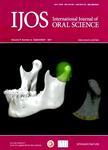E2FBP1 antagonizes the p16^(INK4A)-Rb tumor suppressor machinery for growth suppression and cellular senescence by regulating promyelocytic leukemia protein stability
E2FBP1 antagonizes the p16^(INK4A)-Rb tumor suppressor machinery for growth suppression and cellular senescence by regulating promyelocytic leukemia protein stability作者机构:Department of Immunology Tulane National Primate Research Center Section of Bacterial Pathogenesis Graduate School Tokyo Medical and Dental University Division of Cancer Biology The Cancer Institute Japanese Foundation for Cancer Research Division of Molecular Radiation Biology Department of Radiation Oncology University of Texas Southwestern Medical Center
出 版 物:《International Journal of Oral Science》 (国际口腔科学杂志(英文版))
年 卷 期:2011年第3卷第4期
页 面:200-208页
核心收录:
学科分类:1003[医学-口腔医学] 1002[医学-临床医学] 100214[医学-肿瘤学] 10[医学]
主 题:E2F-binding protein 1 senescence cell cycle ubiquitin promyelocytic leukemia protein
摘 要:Cellular senescence is an irreversible cell cycle arrest triggered by the activation of oncogenes or mitogenic signaling as well as the enforced expression of tumor suppressors such as p53, p16INK4A and promyelocytic leukemia protein (PML) in normal cells. E2F-binding protein 1 (E2FBP1), a transcription regulator for E2F, induces PML reduction and suppresses the formation of PML-nuclear bodies, whereas the down-regulation of E2FBP1 provokes the PML-dependent premature senescence in human normal fibroblasts. Here we report that the depletion of E2FBP1 induces the accumulation of PML through the Ras-dependent activation of MAP kinase signaling. The cellular levels of p16INK4A and p53 are elevated during premature senescence induced by depletion of E2FBP1, and the depletion of p16INK4A, but not p53 rescued senescent cells from growth arrest. Therefore, the premature senescence induced by E2FBP1 depletion is achieved through the pl6INK4A-Rb pathway. Similar to human normal fibroblasts, the growth inhibition induced by E2FBP1 depletion is also observed in human tumor cells with intact p16INK4A and Rb. These results suggest that E2FBP1 functions as a critical antagonist to the pI6INK4A-Rb tumor suppressor machinery by regulating PML stability.



